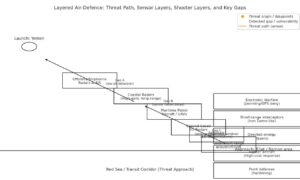By Ch. Haroon Rashid
Abstract
The recent drone strike on Israel’s southern city of Eilat, reportedly launched from Yemen, has raised urgent questions about the effectiveness of Israel’s air defence systems including Iron Dome, David’s Sling, and Arrow. While the attack resulted in about 20–22 injuries, with two serious cases, it exposed repeatable vulnerabilities in layered defence against low-cost, low-signature drones. This article explores how the strike penetrated Israeli defences, what it reveals about the geometry of coverage, and why cost-asymmetric drone warfare is likely to remain a defining challenge in future conflicts.
Background
On September 24, 2025, Israeli media and international agencies reported that a drone launched from Yemen successfully reached the Eilat/Ramon region in southern Israel. Israeli air defences attempted to intercept the drone but failed, resulting in an impact that wounded roughly 20 people, disrupted normal activity, and reignited debates over whether the country’s much-lauded layered air defence can handle massed or low-signature threats from unconventional launch points.
This event is not the first such incident — previous Houthi drone attacks have targeted Ramon International Airport, forcing flight suspensions and highlighting Eilat as a vulnerable target due to its geography and limited sensor coverage.
Short theoretical explanation (how the strike exploited vulnerabilities)
Threat profile & detectability
Small attack drones fly low, slow, and have minimal radar cross-section. They frequently fly in ground clutter or below radar horizon limits, reducing detection range and compressing Israel’s engagement window.
Peripheral geometry & coverage stress
Eilat lies at Israel’s southern periphery, far from central radar clusters and interceptor batteries. Fewer overlapping sensors and longer cue-to-engagement distances create exploitable windows.
Sensor-fusion & decision latency
Even when multiple radar and optical sensors detect a contact, combining these tracks into a coherent, actionable picture takes time. That delay is critical when dealing with slow-moving but precise drones.
Cost asymmetry
Defending against cheap drones with expensive interceptors is unsustainable in the long term. This economic imbalance is a strategic advantage for attackers and a major challenge for defenders.
Standoff launch & escalation complexity
Launching from Yemen or over the Red Sea provides the attacker with deniability and forces Israel into difficult decisions regarding proportional retaliation — complicating escalation management.
Concise takeaway:
This incident does not signal systemic air-defence failure but exposes repeatable gaps: low-altitude detectability, peripheral coverage weaknesses, sensor-fusion latency, and the high cost of interception. These factors will shape Israel’s strategic adjustments going forward.
Diagram – Israel’s Air Defence Layers and Key Gaps

The following visual illustrates the threat path, sensor layers, shooter layers, and three critical gaps that made this penetration possible:
Download the layered air-defence diagram (PNG)
Diagram highlights:
- Gap A: Low-altitude detection weakness (radar horizon & clutter)
- Gap B: Sensor-fusion / C2 delay before shooter cueing
- Gap C: Narrow final engagement window near target
Key Points (Bullet Summary for Readers)
- Drone strike on Eilat shows that low-cost UAVs can bypass layered defence under certain conditions.
- Iron Dome and David’s Sling were either not cued or unable to intercept due to timing/geometry.
- Peripheral geography matters: Eilat is more exposed than Tel Aviv or central Israel.
- Cost-exchange ratio remains heavily attacker-favoured with cheap drones vs expensive interceptors.
- Future conflicts will see more standoff UAS and cruise missile launches across the Red Sea corridor.
Strategic Implications
- The attack will push Israel’s defence establishment to rethink coverage geometry, C2 speed, and cheaper countermeasures like Iron Beam lasers and electronic warfare systems.
- Regional actors will view this as proof that low-cost drones remain viable tools for deterrence, disruption, and political messaging.
- Global militaries should note that layered air defence architectures, while powerful, are not impenetrable — especially at the geographical edges of a nation’s coverage envelope.
Conclusion
The Eilat drone strike is a wake-up call, not a knockout blow. It demonstrates how even one of the world’s most advanced air defence networks can be stretched thin by low-cost, low-signature threats launched from long range. For policymakers, strategists, and security analysts, this incident underscores that UAV warfare, sensor coverage gaps, and cost-asymmetric threats will define the next era of Middle East security. The battle between drones and defences is no longer hypothetical — it is the new normal.










